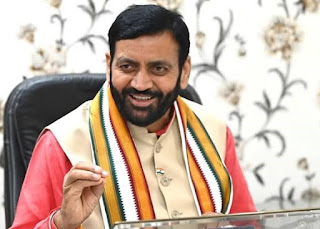According to a statement released on Saturday by the Ministry of Health and Family Welfare, the advancement was made possible by India's extensive Universal Immunization Programme (UIP), which gives free immunizations to 2.6 crore newborns and 2.9 crore pregnant women each year. ASHAs and ANMs are among the healthcare professionals who conduct over 1.3 crore immunization sessions nationwide, guaranteeing extensive vaccine outreach.
India received the coveted *Measles and Rubella Champion Award* from The Measles and Rubella Partnership in March 2024 at a ceremony in Washington, D.C., demonstrating how this success has garnered international attention. India's unwavering dedication to eradicating diseases that can be prevented by vaccination is acknowledged with this award.
India has witnessed notable advancements in general health outcomes in addition to decreases in the prevalence of zero-dose. India's maternal mortality ratio (MMR) decreased to 80 per lakh live births in 2023, according to the United Nations Maternal Mortality Estimation Inter-Agency Group (UN-MMEIG). This is an 86% decrease since 1990, far exceeding the 48% global fall. During the 1990–2023 period, the nation also achieved a 78% decrease in the Under-Five Mortality Rate and a 70% decrease in the Neonatal Mortality Rate, compared to global reductions of 61% and 54%, respectively.
The UIP in India has grown significantly over the last ten years. In 2013, the program included only six vaccines; today, it includes 12 vaccine-preventable diseases, with the addition of the Measles-Rubella Vaccine, Rotavirus Vaccine, Pneumococcal Conjugate Vaccine, and Inactivated Poliovirus Vaccine (IPV).
The government's stepped-up efforts, such *Mission Indradhanush*, have been crucial in reaching marginalized communities. Over 5.46 crore children and 1.32 crore pregnant women who were previously unreachable or under-immunized have been vaccinated since the campaign's inception in 2014, with a notable increase in intensity in 2017.
A focused *Zero Dose Implementation Plan 2024* is presently being implemented in 143 districts in 11 states to close the gaps in vaccine coverage among urban slums, migrant populations, and areas where vaccine reluctance is chronic. Through consistent Pulse Polio campaigns and frequent Village Health and Nutrition Days (VHNDs) for community-based immunization campaigns, India has also been polio-free since 2014.
The *U-WIN platform* is one example of a digital innovation being used to track vaccination data and stop dropouts. Strategies for public involvement, such as street plays and social media outreach, are being employed to raise awareness and lessen vaccine reluctance.
India is beating the world average for all antigens, according to data from the WHO-UNICEF Estimates of National Immunization Coverage (WUENIC) 2023 study. The nation has 93% DTP-1 (Pentavalent-1) coverage, which is far greater than Nigeria's 70% coverage. From 7% in 2013 to just 2% in 2023, the dropout rate between DTP-1 and DTP-3 has also drastically declined. During that time, the percentage of people who had the measles vaccine increased from 83% to 93%.
The administration stressed that India's enormous demographic base must be taken into account when comparing it to other nations. Despite a far bigger birth cohort, India's 0.06% rate shows significant progress, while nations like Yemen (1.68%), Sudan (1.45%), and Nigeria (0.98%) still record high percentages of zero-dose children.









.png)
.jpg)




.jpg)
.png)
.jpg)




.png)







